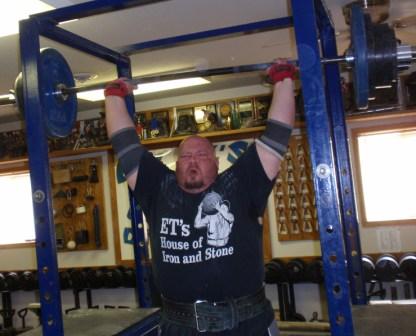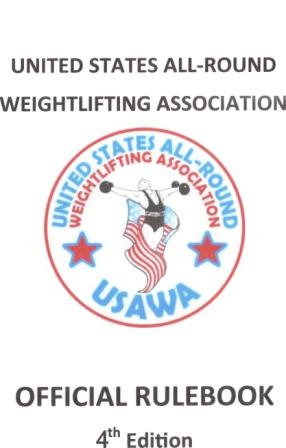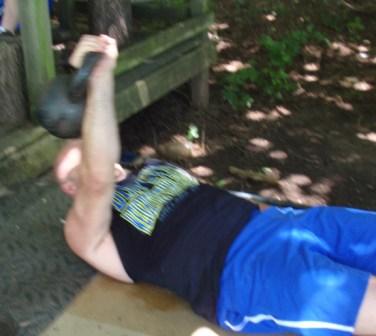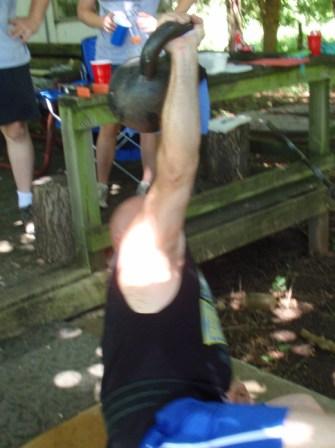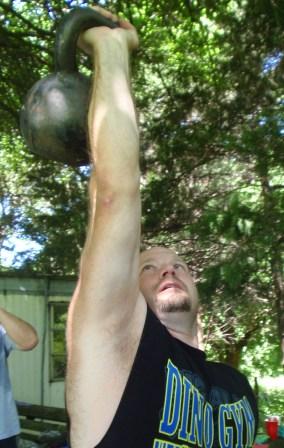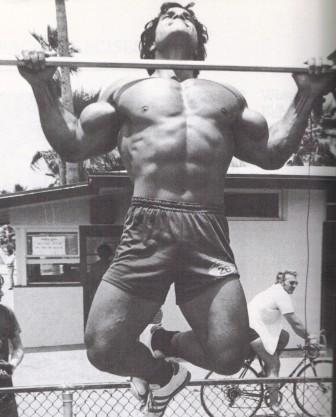by Al Myers
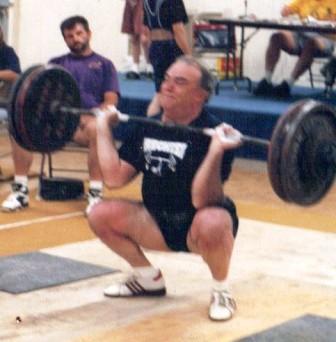
Longtime USAWA veteran Jim Malloy properly demonstrates how to "catch" a Clean.
The Clean is a lift that is not contested by itself in the USAWA as an Official Lift, but is a big part of several other lifts. Lifts like the Clean and Press, Clean and Seated Press, Clean and Push Press, and the Clean and Press – 2 Dumbbells are very common lifts contested in the USAWA. We (the USAWA) define a Clean differently than what is commonly referred to as a “Clean” in gyms all over the country. The USAWA Rulebook clearly outlines the Rules for the Clean:
The bar will be placed on the platform, in front of the lifter’s feet. The lifter will grip the bar with the palms of the hands facing the lifter, and then in one single and continuous movement lift the bar to the chest. The lifter may choose any width of hand spacing. The lift begins at the lifter’s discretion. The lifter may drop under the bar as it goes to the chest, using a squat-style catch in which the legs are bent, or a split-style catch in which the legs split. The lifter may also choose to drop only slightly, using a power-style catch. The bar may touch the lifter’s thighs and body during the lift. The bar must come to rest on the clavicles or on the chest above the pectoral muscle in a smooth continuous movement with arms bent. The feet may move during the lift. The elbows and the upper arms must not touch the knees or legs during the lift or it will be a disqualification. No other part of the body other than the feet may touch the platform during the lift. The lifter will recover and stand when ready, from the squat or split position, to an upright standing position. The legs must be straight with the feet parallel and in line with the torso. Once in this position with the bar motionless and under control, the clean portion of the lift is finished.
As you can see from this Rule Description the bar must go from “the floor to the chest” in one motion. Also, you can not support the bar on the body during a Clean as that is a violation, as outlined in the General Rules of the Lifts in the USAWA Rulebook. Section IX.3 states, “Neither the body nor the equipment may support a weight in any manner during a lift.” Of course if the Individual Rules of a Lift state exceptions then they over-ride General Rules. This is the case with this lift, The Continental to Chest, which in some ways is similar to a Clean. The beginning and end of the Clean and the Continental to Chest is the same – it is just what happens in between that is different! This is where the confusion arises. Continental is even defined in the USAWA Rulebook in the Glossary. It states, “Continental – This means that the lift may be done in any manner, with minimal restrictions. The bar may stop, be lowered, be supported by the body, or be lifted unevenly. The hands do not need to stay on the bar and any grip may be used.” In other words – ANYTHING GOES!!
So, a lift from the platform can be called either a Clean or a Continental. It can not be called BOTH! And please don’t use the terminology “Continental Clean” to describe a lift – that is a misnomer due to being a conflict of description between both words. The USAWA has adopted the “modern day” rules of the Clean. Look back in history and you will see the Rules of the Clean were more difficult than what we use now. The word Clean, was first used because it applied to the bar being taken to the shoulders clean, or clear, of the body. In other words – no touching of the legs on the way up!! How many proficient Olympic Lifters do you see keeping the bar “away” from the body? NONE!! Our Rules of the Clean allow the bar to touch the legs or body without it being a rules infraction.
When the USAWA Rulebook was updated last year, several of the lift names changed to better reflect how the lifts were performed. In example, the “Two Hands Standing Press” was changed to the “Clean and Press”. The new updated Rulebook (the 4th Edition which will be released the first of August) will have some added rule descriptions as it applies to a Dumbbell Clean. This will be added, “Both dumbbells must be cleaned at the same time and in one motion from the platform to the shoulders. It is an infraction to clean the dumbbells from the hang position”. THAT is the way it has always SUPPOSED to have been but I wonder how many times, because it wasn’t laid out clearly in the Rulebook, this rule of the clean has been violated. I’m willing to bet that several records have been recorded in the USAWA Record List where the dumbbell/or dumbbells were taken to the shoulders using a Hang Clean. Here is an example that I am sure even some “seasoned officials” have been confused on. Both are one arm dumbbell lifts in which the dumbbell needs to be taken to the shoulder first in order to perform the lift. What is the difference in taking the dumbbell to the shoulder between the “Clean and Jerk – Dumbbell, One Arm” and the “Press – Dumbbell, One Arm”? You should now know this if you have been reading and following what I have described above. In the first lift the dumbbell needs to be Cleaned correctly, while in the second lift the dumbbell can be taken to the shoulder in any manner, even using BOTH HANDS. Our previous Rulebooks called these two lifts the “One Hand Clean and Jerk with Dumbbell” and the “One Hand Dumbbell Press”. It would be easy to see how the name “One Hand Dumbbell Press” could imply that ONLY ONE HAND must be used throughout, which is not the case.
Our Rulebook is far from being perfect. However, it is far better written now than before. If we continue to update and correct it every year with issues like this brought up during the year, it will only get better.
